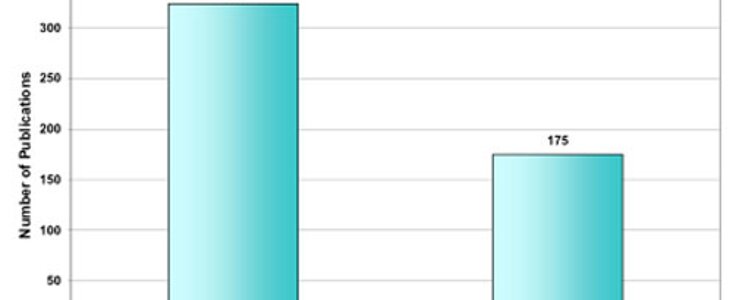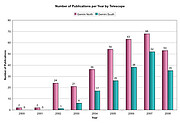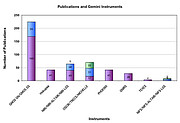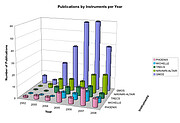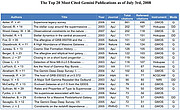The 500th Referred Gemini Paper
8 Julio 2008
In mid June 2008, the 500th refereed Gemini paper was accepted for publication in The Astrophysical Journal, one of the main refereed astronomical journals. The last time we reported on Gemini papers statistics was on September 27th 2007 for the 400th Gemini paper.
The 500th paper is titled “First Stellar Velocity Dispersion Measurements of a Luminous Quasar Host with Gemini North Laser Guide Star Adaptive Optics”, 2008, The Astrophysical Journal, by Linda C. Watson and 7 co-authors. Linda C. Watson is a Ph.D. student at the Department of Astronomy of the Ohio State University. The authors team consists of researchers from the United States, Canada and Germany. The paper presents new results on the kinematics of stars orbiting at the heart of the quasar host galaxy PG 1426+015 (z = 0.086). The velocities were derived from high spatial resolution near infrared spectra obtained with the integral field unit spectrograph NIFS. The team of researchers used the new Gemini North Laser Guide Star Adaptive Optics facility to observe this faint target, and assess the properties of the central stellar population and derive the mass of the supermassive black hole powering the quasar. More details on the content of the 500th paper can be found here.
Of course this particular paper provides only a glimpse of the diversity of research performed at Gemini Observatory since the first wave of papers started to appear in 2002. A scan of our publications archive reveals an extraordinary range of research and discoveries that is continually expanding and diversifying, creating a significant legacy for generations of scientists and the public. Several findings have also been reported and highlighted in the Gemini newsletter, GeminiFocus, and on the Gemini website, and an archive of web summaries is available here.
The figures and tables below display the trends of Gemini refereed publications as a function of telescopes, instruments and calendar year. In Table 1, we present a comparison of the number of papers between Gemini instruments using a simple “productivity index” of the number of hours required on average to produce a paper. The lower the number of hours the more “productive” an instrument has been. This is only one of the possible measures to assess the relative impact of Gemini instruments. In Table 2, we show the list of the 20 most cited Gemini papers (citation counts as of early July 2008).
| Instruments | # papers | Hours per paper* |
|---|---|---|
| T-ReCS (mid IR imager-spectrograph) | 26 | 17 |
| MICHELLE (mid IR imager-spectrograph) | 17 | 18 |
| GMOS-N (optical MO/IFU spectrograph) | 169 | 19 |
| GNIRS (near IR spectrograph) | 28 | 19 |
| OSCIR (mid IR imager – retired) | 17 | 21 |
| Hokupa’a-36 (adaptive optics imager -- retired) | 40 | 21 |
| NIRI (near IR imager/spectro)/ALTAIR | 40+24 | 25 |
| GMOS-S (optical MO/IFU spectrograph) | 56 | 27 |
| PHOENIX (near IR HiRes spectro) | 41 | 32 |
Table 1. Instrument relative “output”: number of refereed papers and “output index” in terms of hours of telescope time as number of hours to produce one paper. Paper count is as of mid-June 2008, and hours charged as of end of 2005B.
Notes
- Gemini maintains an up-to-date database of papers based wholly or in part on Gemini data that appear in the main refereed astronomical research journals. These journals consist of: The Astrophysical Journal, The Astronomical Journal, Astronomy & Astrophysics, Monthly Notices of the Royal Astronomical Society, Publications of the Astronomical Society of the Pacific, Icarus, Science and Nature. In a few exceptional and well-assessed cases, we also count papers from “secondary” journals.
- Gemini’s qualifying criterion is the same as that used by the Space Telescope Science Institute and European Southern Observatory. To qualify, papers based on their output, must employ in an original way an image, spectrum or data set produced by Gemini to derive new scientific results. No attempt is made to fractionate papers per telescope used in the case of papers based on the use of two or more other facilities. Hence, the same paper may be counted several times, for example by Gemini, Keck and Subaru, if it includes data from any of these telescopes.

